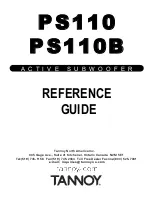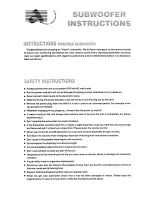
Connecting Your Subwoofer
If your receiver has a subwoofer output:
(Most modern receivers do)
1.
Run a dedicated RCA type subwoofer cable from the
receiver’s subwoofer output to the subwoofer input
labeled LFE. It is best to use a shielded cable for your
subwoofer so other pesky signals don’t worm their way
into your precious bass.
Note:
When connecting via the LFE input, the
internal crossover is disabled. You will have to do all
bass management within your home theater receiver.
2.
If your subwoofer cable has to cross the power cable
for another electronic device, have it cross at a 90
degree angle.
3.
Plug the power cable into the back of your subwoofer
and into a wall outlet or power strip. DO NOT plug it
into the back of your receiver or preamp.
Note:
Most subwoofers have both left & right inputs.
Since the sub signal is mono, it doesn’t matter which
one you use. Some people will buy a “Y adapter” or
“splitter” so that a single cable can feed both sub-
woofer inputs. There’s no harm in doing this, the
reason subwoofers have L & R inputs is so that if you
have a stereo pre-amplifier, you can use both “pre-
outs” to the subwoofer without losing any bass.
If your receiver DOES NOT have a subwoofer output:
1.
Run speaker wires from your receiver (or your front
left & right speakers) to the subwoofer’s high-level
inputs.
2.
Since speaker wire is typically unshielded, it’s best
to steer clear of household wiring. If it does need to
cross the power cable for another electronic device,
have it cross at a 90 degree angle. If your subwoofer
emits a buzz or a hum, this may be the culprit.
3.
Plug the power cable into the back of your subwoofer
and into a wall outlet or power strip. DO NOT plug it
into the back of your receiver or preamp.
Subwoofer Controls
In addition to the low-level inputs and outputs on the
rear of your subwoofer, you will see two round knobs and
two switches. The first knob, labeled “LEVEL”, controls
the subwoofer’s volume. The second knob, labeled
“CROSSOVER”, sets the crossover frequency which is
the frequency point where the subwoofer takes over from
your other speakers to produce the bass you hear.
The power switch has two settings - on and off. When
the switch is set in the “on” setting, the power lamp will
be illuminated green. When set to the “off” position, the
power lamp will turn off. The “phase” switch reverses
the subwoofer’s polarity. If the distance from the sub to
the listener is significantly different than the front and
center speakers (>3’), try using the phase reverse switch
to see if it improves the bass response.
Your Aperion Bravus subwoofer has a switchable voltage
control. Please be sure to select 115V for use in
the USA.
Subwoofer Configuration
After you’re all hooked up, its time to get rockin’. To get
you started, our recommendations for initial settings are
listed at the right.
Personal tastes vary, so we strongly recommend that you
play with the settings. In additon to being fun, this
helps you understand your subwoofer and gives you a
custom configuration for your listening tastes and your
room.
As always, if you need any help, please feel free to give
us a call at 1.888.880.8992 and one of our Home
Theater Gurus will be happy to answer any questions you
have or help you get room-shaking bass out of your
subwoofer.
Recommended Initial Settings
Phase:
0º
Crossover:
60-100 Hz
Level:
1/3 to 1/2 Power
Power:
On
LEVEL
MIN
80Hz
120Hz
40Hz
160Hz
0
180
MAX
CROSSOVER
PHASE
CAUTION
RISK OF ELECTRIC SHOCK
DO NOT OPEN
Speaker Level Outs
High Level
Inputs
115V~/230V~
300W,60HZ/50HZ
POWER
ON
OFF
6.3AL/250V,120v~
3.15AL/250V,230V~
Bravus
II
+
+
+
+
-
-
- -
or
CAUTION
RISK OF ELECTRIC SHOCK
DO NOT OPEN
PRE OUT
SW
6.3AL/250V,120v~
3.15AL/250V,230V~
115V~/230V~
300W,60HZ/50HZ
230V
~
11
5V
~
+
-
HI LEVEL INPUTS
USB POWER
5V/250mA
POWER
ON
OFF
LFE
70Hz
180º
0º
120Hz
MIN
MAX
VOLUME
CROSSOVER
PHASE
ON
AUTO
OFF
POWER
RIGHT
LEFT
Bravus
II
Bravus II Subwoofers
Aperion Audio
5
6
Subwoofer Controls & Configuration
Connecting Your Subwoofer
























